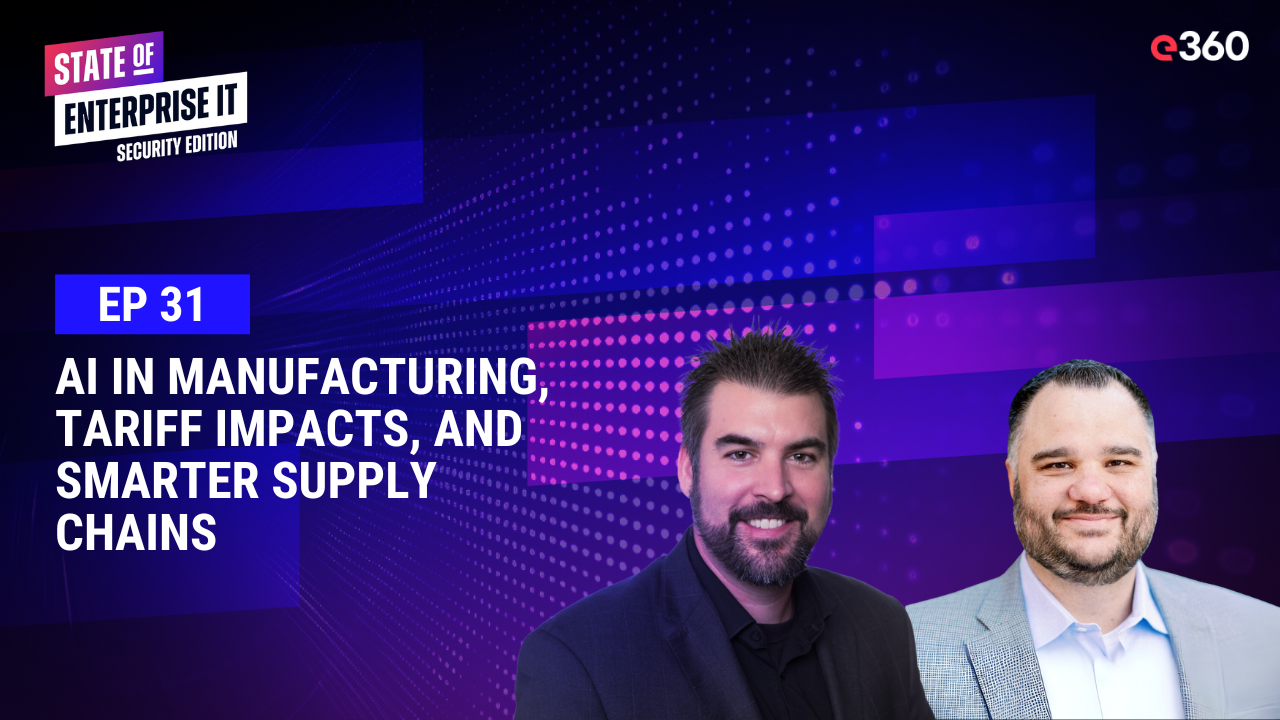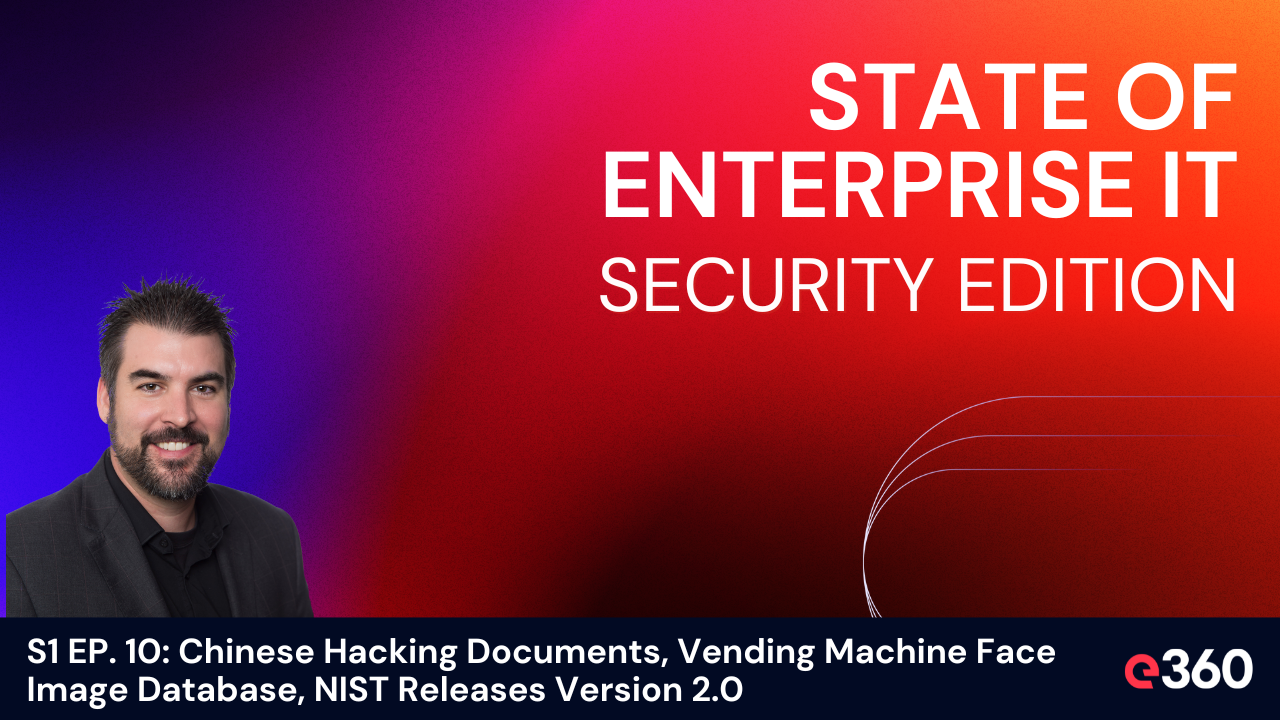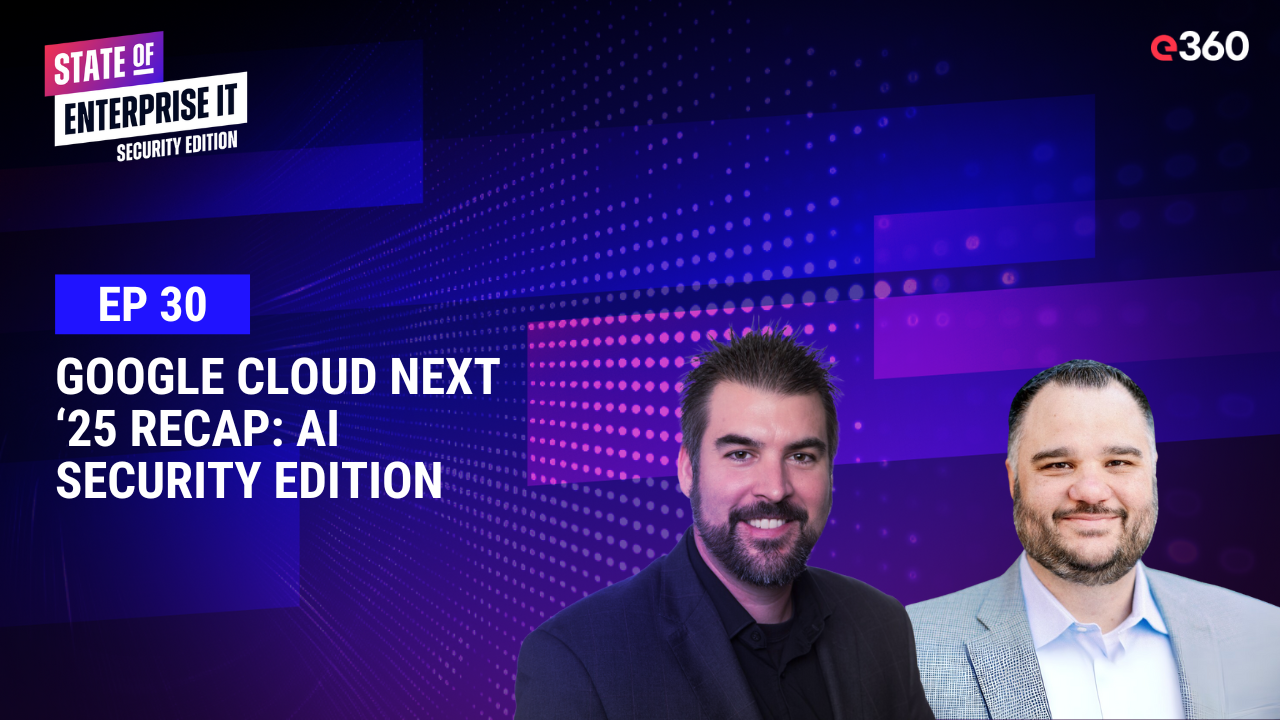Introduction
In this episode of the State of Enterprise IT Security Podcast, Brad Bussie and e360 Field CISO Mark Aksel explore how AI is revolutionizing manufacturing. From predictive maintenance to smarter supply chain strategies and the impact of global tariffs, they break down how technology leaders can future-proof operations and make better boardroom-level decisions.
Listen the Episode
Watch to the Episode
Topics We Cover
AI in Predictive Maintenance and Quality Control
Brad and Mark discuss how manufacturers can leverage AI to predict equipment failures before they happen and improve quality control in real-time using computer vision. They explain that many manufacturing lines today still rely on outdated equipment, creating opportunities—and challenges—for AI retrofits.
Navigating Tariffs and Global Supply Chain Shifts
The conversation turns to tariffs and how they're impacting hardware costs and supply chain dynamics. Companies are shifting production from China to countries like Vietnam and India to mitigate these unpredictable trade impacts. Using AI to model supply chain scenarios and plan around tariffs helps organizations stay resilient and competitive.
Data Readiness and Security Implications
No AI discussion is complete without addressing data. Brad emphasizes that successful AI initiatives start with clean, high-quality data. Without it, AI models risk making poor or even harmful decisions. Mark highlights the importance of security leaders embracing AI as a business enabler while ensuring strong governance and oversight.
Key Takeaways:
-
Predictive maintenance is no longer futuristic — it's a practical way to reduce downtime and extend equipment life.
-
Computer vision offers real-time quality control, minimizing waste and saving costs.
-
Tariff volatility demands smarter supply chain planning and scenario modeling.
-
AI adoption requires trusted, high-quality data and careful governance to prevent overreliance or unintended consequences.
-
Security teams should shift from being blockers to strategic partners, helping organizations move forward safely and effectively.
Read the Transcript
Of course! Here’s the full clean transcript from EP. 31, with content-based section headings instead of speaker names. This keeps it easier to read and organize while staying true to the episode.
Introduction & Why Focus on Manufacturing
[00:00:32]
Hey everybody, I'm Brad Bussie, Chief Technology and Security Officer at e360. Thank you for joining us for the State of Enterprise IT Security edition. This is the show that makes IT security approachable and actionable for technology leaders.
Today, we have Mark Aksel, our Field CISO at e360. By now, backed by popular demand, we might just make Mark a permanent part of the show.
Mark jokes about renegotiating his contract, and Brad shares that this season they're shifting to focus more on specific industries rather than covering multiple topics per episode.
They chose manufacturing because tariffs keep coming up, and manufacturing is especially vulnerable due to supply chain challenges. Technology leaders need to think about these topics because even cloud and server components depend on manufacturing.
Client Discussions: AI Opportunities and Predictive Maintenance
[00:03:02]
Brad describes a conversation with a client who manufactures a widget. The client was worried about being left behind on AI efficiencies. The CFO had been tasked to look into AI but struggled to see how it could be used in their manufacturing process.
Brad asked if their lines ever go down — the answer was yes, all the time, due to maintenance and equipment failures. They discussed predictive maintenance, and it turned out the client had logs going back 20 or 30 years, meaning they actually had enough data to start predicting failures and preventing downtime.
Using Sensors and Predictive Purchasing
[00:05:49]
Mark expands on predictive maintenance, explaining the use of sensors to detect abnormal machine behavior and catch fractures or weaknesses before they fail.
They also discuss predictive purchasing — "buy low, sell high" applied to machine operations. Some machines can’t just be turned off; they need to keep running at a minimal level or restarting them becomes a massive effort. Predictive analysis helps plan operations more effectively.
Mark also touches on the security perspective: how to protect these systems and data streams when introducing more automation and monitoring.
Quality Control and Computer Vision
[00:07:22]
Brad talks about traditional quality control processes where the line stops and samples are manually inspected.
They suggest using computer vision to monitor every widget as it’s made in real time. If something goes out of spec, the system can automatically stop the line, make adjustments, and resume production.
They also mention supply chain forecasting as another area where AI can help manage unpredictable tariffs and fluctuating demand.
Mark’s 3D Printer Example
[00:09:12]
Mark shares a personal story about his 3D printer, which was impacted by tariffs. The printer uses cameras to monitor prints and adjusts in real time, stopping when something goes wrong to avoid wasting material.
Scaling this approach to large manufacturers could save significant costs.
Challenges with Older Equipment
[00:10:40]
Brad explains that many manufacturers operate with equipment that is 30+ years old, lacking network integration and sensors.
In contrast, pharmaceutical and biopharma sectors often have newer, more modern equipment, but simpler manufacturing processes (like making cans) often don't.
Mark describes how legacy equipment is sometimes air-gapped and surrounded by secure layers, making it hard or impossible to update. Some medical machines still run Windows XP and can’t be patched, so they rely on external protections.
How AI Can Help Offset Tariff Challenges
[00:13:31]
Brad describes industry approaches to offset tariff impacts: optimizing supply chains, rerouting or resourcing based on costs, and scenario modeling to simulate tariff effects on pricing and profit margins.
They mention automated compliance, AI-enhanced customs documentation, and demand sensing — adjusting production based on expected demand shifts driven by tariffs.
Some clients have moved manufacturing from China to countries like Vietnam and India to save costs and mitigate future risks.
Budget Strategy and Security Implications
[00:15:53]
Mark talks about future-proofing supply chains and the importance of having multiple suppliers.
From a security perspective, he suggests extending maintenance on equipment instead of replacing it right away and repurposing that budget for high-priority needs, like security improvements.
They discuss "stretching dollars" and how CISOs often explore these approaches to do more with limited resources.
The Importance of Data Quality and Human Oversight
[00:18:05]
Brad emphasizes that all of these AI-driven decisions rely heavily on good data.
He warns about the dangers of poor data quality or biases that can undermine AI outcomes. Over-reliance on automation without human oversight is risky — humans still need to validate and guide decisions rather than blindly trusting models.
Future Applications: AI for Policy and Trade
[00:21:15]
Brad proposes using AI as an advisor for trade policy and legal decision-making — not for governments, but for internal teams making yes/no decisions based on hard data.
Mark predicts a future where AI will talk to other AI systems, with humans simply reviewing the final outcomes.
Automating Third-Party Risk and Contracts
[00:23:00]
Brad imagines an AI system that could handle third-party risk questionnaires automatically, validating controls and policies with other companies’ AI — eliminating the need for repeated manual answers.
The Potential Economic Shifts from Tariff Changes
[00:24:15]
Brad discusses the unintended consequences of trade wars — for example, factories in China shutting down because Americans are no longer buying certain products.
He also mentions that GenAI will increasingly be used in business operations, particularly for reviewing contracts and analyzing trade agreements.
Boardroom-Level Decisions and Readiness Checklists
[00:26:00]
Brad explains that manufacturing transformation isn't just about factory-floor tech; it's about making smarter, strategic decisions starting at the boardroom level.
They announce a forthcoming AI readiness checklist for manufacturing (and other industries), designed to help organizations assess if they’re ready to start these initiatives.
Security as an Enabler
[00:28:01]
Mark highlights that security should help "light the path" forward instead of being the department that blocks innovation.
They agree on using a "yes, and" approach — supporting progress while ensuring it's done safely.



